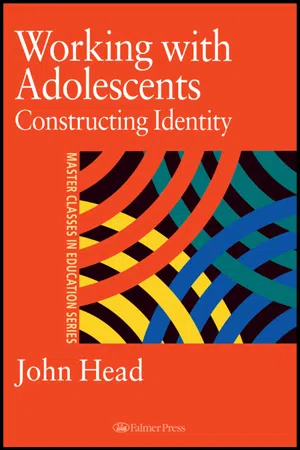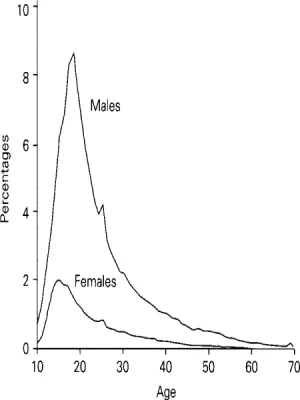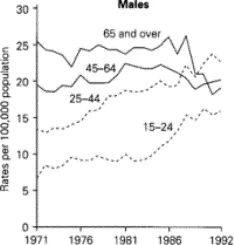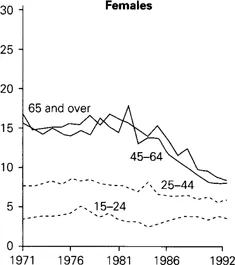Chapter 1
Introduction: Perspectives on Adolescence
The common dictionary definition of adolescence, as the phase of life between childhood and adulthood, gives no hint of the concerns and controversy which surround it. Within our culture adolescence is often seen to possess some unique quality which distinguishes it from other parts of the life-span. There is less agreement about the nature of this quality.
Often there is a very negative image. In part this comes from tabloid newspaper headlines about drugs, sex and crime. Tales are told of insubordinate youth in schools and anti-social behaviour outside school. Parents tell of happy and sociable children becoming sullen and uncommunicative teenagers. Given this picture we might think that one needs considerable tolerance and skill to work successfully with adolescents.
There are conflicting stories. Many adults will recall adolescence as a vitally important time in which life-long friendships were established and life-long values and interests emerged. Adolescence can be a time of enthusiasms and idealism and many teachers will testify to the exhilaration which can be experienced in working alongside young people.
Making sense of these conflicting images might be facilitated by seeing how our notions of adolescence as a special phase of life, one of storm and stress, evolved over the last two centuries.
Storm and Stress?
In pre-industrial societies children help in the home and with work as soon as they are able and, in so doing, become quietly initiated into adulthood. Puberty is often marked by some initiation ceremony, echoed by the Bar Mitzvah and the First Communion in our society. Some change in behaviour is expected after this initiation. For example, boys who previously lived with other children and the women may now be expected to keep the company of the adult men. The extended period of adolescence, as we know it, is collapsed in these societies into the short period of initiation, so that someone would be perceived as child one day and as an adult the next.
Even in such societies some tension between youth and adults was reported. In Classical Greece it was lamented that the youth of the day did not properly respect their elders and in 1590 the Recorder of London commented on the ill behaviour of gangs of youths in the city. In 1517 a riot among apprentices in London led to 300 arrests and one death. If in Tudor England the family and community could not provide for all in the home then it was expected that it would be the young men who would travel in search of employment. There is the old adage that ‘girls take root while boys take flight’. The existence of a nomadic population, dependent on casual employment, charity, or in extremis petty crime, for survival gave cause for concern. It might be noted, however, that the comments were solely about the social behaviour of a sub-group within society and no attempt was made to engage with the minds of individual youths.
The big change came with the Romantic movement in Europe, leading to the observation that ‘The adolescent was invented at the same time as the steam-engine’ (Musgrove, 1964). Rousseau addressed the condition of childhood but Goethe had a greater influence with respect to adolescence. In 1774 he wrote The Sufferings of Young Werther which described a sensitive youth experiencing suicidal despair in facing the adult world. The book was an instant success and legend has it that there was a rash of similar suicides across Europe. A whole genre of similar literature then developed, being given the name Sturm und Drang after the title of a play by one of Goethe’s associates, Friedrich von Klinger.
It is important to note that Goethe did not give a totally negative account of adolescence. Towards the end of his life, in conversation with Johann Eckermann in 1828, he credited his continuing creativity to having experienced ‘repeated puberty’. His thesis was that adolescence might be marked by emotional turbulence but this provided the source for artistic achievement. Certainly, introspection became commonplace among the later Romantics, as demonstrated by Wordsworth in his autobiographical account, The Prelude, with the sub-title Growth of a Poet’s Mind. It is not clear from these writings the extent to which the descriptions of adolescence were meant to describe the experience of all young people or solely those of an artistic temperament.
The first major psychological study of adolescence, by Stanley Hall in 1904, reinforced the notion of a time of storm and stress for all adolescents. Hall’s writing combined a curious mix of careful detailed descriptions with strange explanatory models. He was strongly influenced by Darwin, and argued that each person’s life-span recapitulates the evolutionary history of mankind. Within this bizarre theory adolescence corresponded to time when people became civilized, and there was tension between primitive desires and the influence of a civilized society.
A similar argument was made more cogently within psychoanalysis, when Freud moved the conflict between God and the Devil from outside a person to it being something within the mind. He postulated a struggle between the primitive instincts of the id and the moral conscience of the super-ego, with the ego, the more conscious and rational part of the mind, holding the balance. This model has been memorably likened to that of a sex-crazed monkey being in a perpetual struggle with a maiden aunt while the fight is refereed by a nervous bank clerk.
Figure 1: Percentage of age cohorts in England and Wales convicted or cautioned for an indictable offence in 1993
Source: Social Trends, 1995. Crown Copyright 1995. Reproduced by permission of the Controller of HMSO and of the Office for National Statistics.
Sigmund Freud did not pay much attention to adolescence, arguing that problems at this time of life were simply the continuation of problems unresolved in childhood. His daughter, Anna Freud, in her book The Ego and the Mechanisms of Defence published in 1937, took a different line. She argued that the child by the age of about six or seven has established a modus vivendi allowing it to cope successfully with the next phase of childhood, the so-called latency period, in which the child enjoys a time of psychic stability. However, the growth of sexual feelings accompanying puberty strengthens the id, so that for a while the psychic balance is disturbed. Consequently, according to this argument, there will inevitably be a period of storm and stress before a new equilibrium is established. Further writing within the psychoanalytical tradition, such as Blos (1962), has reinforced the notion of adolescent trauma, with him describing it as a time of a second individualization, completing the process which commenced at birth.
Reference has been made to the evidence for adolescent trauma. The story is confused. On many headings, such as that of physical health, it is a relatively trouble free time, with menstrual difficulties among the girls being the main exception. Other indicators tell a different story. Examination of Figure 1, showing the crime figures in Britain in 1993, show that the occurrence of indictable offences peaks strongly with males at about the age of eighteen, when over 8 per cent of the age cohort are convicted or cautioned. There is a much smaller peak with females at about the age of fifteen. Overall, 26 per cent of all known offenders are aged under eighteen.
With young women other indicators, notably eating disorders, are worrying. It is difficult to provide a precise figure for the incidence of such problems, as only the most severe cases are likely to be reported. The two commonest explanations for these disorders are a wish to appear very slim, as such a body shape is deemed attractive, and in some cases a wish to reverse the physical symptoms of puberty, specifically menstruation.
Figure 2: Suicide rates: by gender and age in England and Wales 1971–1992
Source: Social Trends, 1995. Crown Copyright 1995. Reproduced by permission of the Controller of HMSO and of the Office for National Statistics.
Some of the indicators show historical changes. Suicide rates have traditionally been low among this age group, but Figure 2 shows that between 1971 and 1992 the rate for males aged 15 to 24 more than doubled, from about 7 per 100000 of the population, to over 15, whereas among older males the rate decreased. There was no corresponding increase in suicide rates among young women where the figures have remained at just under 4 per 100000.
Other evidence is open to conflicting interpretations. In recent years the number of pupils permanently excluded from our schools has increased, but this finding can be seen either as evidence of an increasing number of young people behaving badly, or as evidence that with the increasing competition among schools they are less willing to tolerate disruptive students. We also know that the use of cannabis among young people over the age of fifteen has now almost become the norm. How alarming we find that statistic depends upon our beliefs about the likely dangers coming from the use of that drug.
Activity
Recall your own experience of adolescence, and that of your contemporaries, in order to judge the extent that it was a time of storm and stress. It might help this task to make separate lists of the positive and negative aspects which you recall. The items listed form an agenda which should be addressed somewhere in this book. How is your list affected by your gender, race or class?
The Essential Tasks of Adolescence
What emerges from this data is a complex and, to some extent, a contradictory picture which needs careful analysis to provide understanding. We must look beyond the too prevalent media scare stories to gain such understanding.
The weight of contemporary psychological opinion is that adolescence is not unique in being a time of extraordinary stress. However, each phase of life tends to present a specific set of stressors. A young adult coping with the demands of work and raising a family may envy the apparent care-free life of the adolescent. An older adult, who may be lonely now the children have grown up and left home, may envy those who have a young family. According to the criteria we select it is possible to make a case for any phase of life to storm and stress.
Adolescents have to cope with a number of tasks. Individually, the central task is to achieve a sense of personal identity and that concept, which is developed in the next chapter, provides an explanatory thread which then runs through the whole book. Achieving the autonomy necessary to become adult demands a change in the relationships with parents and teachers. The loosening of the ties with adult authority figures is compensated for by increased importance of relations with peers. The strength of the peer group influence can be positive, many adults testify to the value of friendships established in youth, but can also lead anti-social gang behaviour. A further complicating factor comes in the establishing of sexual relationships. Finally, adolescents as a social group occupy an ambiguous position in our society.
Given this agenda, of handling issues of identity, autonomy and changing relationships, it may be surprising that in general adolescents cope so well, without much trauma (Murray and Dawson, 1983; Davis, 1990). Coleman provides explanation terms of a focal model (Coleman, 1974; Coleman and Hendry, 1990). He suggests that adolescents cope by tackling the issues one at a time, and only after one has been resolved is the next addressed. In this fashion the stress at any given time is manageable. Obviously, the exact sequence depends on the individual, but his findings, as shown in Figure 3, suggests that among boys the biggest anxiety at the age of eleven is about the potential of heterosexual activity; for boys of fourteen and fifteen it is about rejection by the peer group; and at seventeen the biggest problem tends to be about relations with parents.
It is an open question whether adolescents face a more difficult task in growing into adulthood nowadays compared to the recent past. What is beyond dispute is that they are having to enter into a society which is undergoing rapid change. There i...







